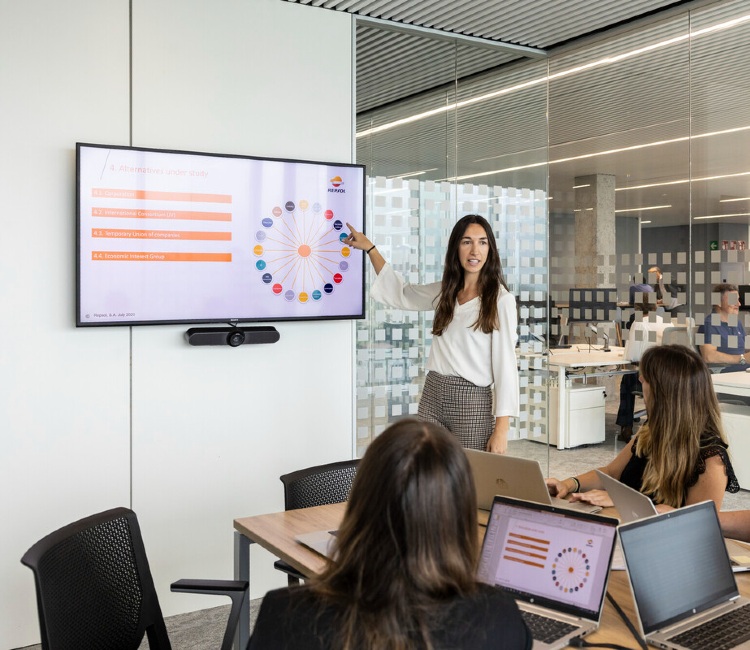| Clients |
Customer voice.Customer service attended (face-to-face, telephone, mail, etc.).Digital services (Waylet chatbot, forms, etc.). |
To get to know the customer in greater depth, their consumption habits, preferences and suggestions.To respond to claims and complaints. |
Customer voice analysis.Assessment of the customer care service.Definition and results-based improvement
plans. |
| Shareholders and the Financial Community |
Results presentation, roadshows with senior management participation, General Shareholders' Meeting, Engagement Report. |
Maintain excellent communication and transparency with shareholders and the financial community, explaining our profitable energy transition strategy with attractive returns for our stakeholders. |
During 2024, the Board of Directors submitted Repsol's energy transition strategy for advisory approval at the 2024 General Shareholders' Meeting. |
| Suppliers, contractors and partners |
Engagement and communication with suppliers and contractors in the purchasing and contracting processes.Communication with contractor companies within the framework of the Safety Excellence Program, through individual meetings to address concerns and suggestions, open webinars to disseminate topics of interest, and structured work sessions at different levels. |
Search, selection, contracting and evaluation of the supplier, carrying out due diligence and attending to the needs that may arise during the life of the contract.Promote safety in operations through constant and coordinated communication with contractors, addressing challenges and best practices, and driving continuous improvement in work processes aligned with the principles of the Excellence Program. |
Integration into the procurement and contract process based on the results of supplier performance evaluations.Incorporation of suggestions to optimize processes and performance in safety, strengthening coordination and continuous improvement in operations. |
| People in the Organization |
Liaise with workers' representatives via committees and work groups.Surveys of satisfaction and commitment to work within the Nuestra Voz program.Direct listening channels, such as the People and Organization teams in each area and country, the Employee Service (SAE) and the intranet as a space for communication and resources.Collaboration spaces such as events and specific sessions. |
Understand and address the needs, interests and concerns of employees, effectively collecting opinions, suggestions and incidents, to maintain a motivating and productive work environment.Promote an open and transparent dialogue that allows identifying areas for improvement and strengthening working conditions.Promote the active participation of employees in the continuous improvement of the work environment. |
Specific action plans that driv engagement, satisfaction, and career development.Collective bargaining and concrete measures to improve working conditions, with continuous monitoring of their evolution. |
| Public Administrations and Organizations |
Participation in regulatory processes, events, informative round tables and collaboration meetings with public representatives. |
Convey Repsol's vision regarding those issues related to the activity it carries out, with the aim of obtaining the institutional, legislative, and social license necessary to operate. |
Regulatory and advocacy strategy 2024-2027.Annual regulatory management plan, through the Regulatory Coordination Committee, with a focus on priority cross cutting files.Integrated vision of Repsol's participation in organizations and associations to support correct representation. |
| Company |
Participatory dialogue with communities in the area of influence of operations throughout the life cycle. Shared value agreements. |
Maintain transparent communication about operations. Proactive dialogue and responsible and transparent management of impacts. Obtain your social license to operate. |
Participatory processes on projects.Definition and participatory monitoring of improvement plans.Signing of agreements with the communities.Follow up of inquiries and complaints received. |
| Media and opinion makers |
Press releases, meetings with the media, corporate websites, social networks and contacts with the media offering technical training sessions. |
Convey a unique, integrated, and global image of Repsol, projecting a consistent image that allows the Company to be recognized. |
Nearly 20 visits and attendance of more than 120 journalists to the Tech Lab and the renewable fuels unit of the Cartagena refinery, attended by more than 120 journalists with the main objective of bringing the media, their professionals and other opinion leaders (social media influencers) closer to why Repsol is committed to renewable fuels, how they are generated, where, how and why. |
| Business ecosystem |
Meetings, seminars, conferences, working groups, participation in industry associations. |
Acting in a coordinated manner in business, sectoral and cross-sectoral partnerships to achieve greater impact and facilitate collective decision-making. |
Active participation in the development of guides and tools that we incorporate into our internal management processes.It offers the opportunity to have dialogues with peers to reinforce sectoral positions. |
| Innovation and entrepreneurship ecosystem |
Innovation hubs through which proofs of concept are developed with startups, R+D centers, universities and other corporations and technological conferences are held. |
Accelerate the development of our own technologies and/or projects, to achieve the goals set to be net zero emissions by 2050, through innovation and collaboration. |
Creation of the All4Zero industrial innovation hub together with large cross sector corporations to scale, through collaboration with startups, universities and R+D centers, technologies focused on decarbonization and circular economy.The All4Zero association was officially constituted in January 2024 and since then work has been underway on the implementation of 12 innovative proofs of concept with the stakeholder group. |



